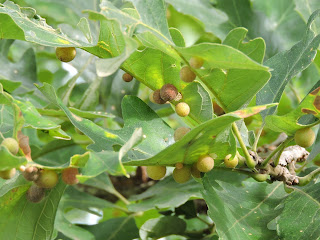As I walked by Fen Ridge the other day, it occurred to me that there was more to add on the subject of galls. As colours change and leaves thin, other interesting forms become more visible. The lovely sumac who gives such a vibrant display in the fall, might also have what look like oddly shaped fruit on it. These are the work of the Sumac Gall Aphid, Melaphis rhois, and research by a professor at Shangxi University in China has established a prehistoric connection between Asia and North America for this little aphid traveler. Mama aphid lays some eggs on the leaf and the reaction by the sumac host is to build a lovely pod to house and feed the multiplying numbers of tiny yellow aphids. Canadians are ever hospitable. I have most often seen only one or two galls per leaf but this is a whole neighborhood.
Blackberry canes are the address of choice for the Diastrophus nebulosus wasp, (should possibly be disastrophus). The resulting structure, called a blackberry knot gall, becomes a multi-chambered winter home for the growing wasp larvae. By the spring this lumpy, purple gall will be brown and woody, with round exit holes from each of the inner chambers.
The Willow pine cone gall is a bachelor apartment inhabited by a single gall gnat midge, or fly. The midge deposits the egg and when it hatches the larvae burrows into the growing end of the stem. The willow's response is a multi-layered leafy structure that resembles a pine cone particularly in the winter when the gall becomes brown and brittle. These galls will often remain attached to the plant long after it is vacant.
I discovered these last autumn when the leaves had fallen making them visible. They are called oak nuts, or oak marble galls, and are caused by a tiny gall wasp called Andricus kollari. The exit holes are clearly visible and the gall is hard and hollow.
I saw these oak galls this morning and after trying diligently to identify them have decided to refer to them as an oak leaf gall, found on the underside of the leaves and attached along veins. The waspish inhabitant(s) shall have to remain nameless at this time. I didn't see any exit holes so they must still be occupied.
This was found nestled in the grass so I had no idea where it came from or what it was. It is about the size of a toonie and lovely mottled browns and purples. I eventually matched it to photos of Acorn Plum Galls which are inhabited by a single gall wasp larvae. It is purple inside and certainly looks like a plum. The gall grows at the base of the acorn cup, hence..
This oak leaf has a cluster of small cylinder shapes on its underside. I discovered that not only were gall wasps making themselves at home on this oak, but these were the eggs of the stink bug. Orkin Canada says that there are over 260 species in North America, but of recent concern is an Asian immigrant called the Brown Marmorated stink bug, because it can cause potential crop damage. The good news for the poor beleaguered oak tree, is that these various visitors generally cause no lasting damage to the tree.
Lastly, for now anyway, is the Pine-oak Gall Rust. This is different in that the galls are the result of a fungal disease, and two different host plants are required for the disease's life cycle. In the spring spores are released into the air from infected oak leaves and these infect young needles on a pine tree. The fungus moves from the pine needles to a branch where it settles and the gall begins to form. When the gall matures the bark on the outside cracks releasing powdery orange spores, which then travel to a nearby oak and infect the leaves.
An article by the USDA Forestry Service described burls, gall and tumours, as all being "abnormal swellings", caused by bacteria, insects, fungus or possibly environmental stresses on the tree. It would be interesting to know what caused the distortion of this tree trunk because it sure is gnarly. The tree seems very healthy so there will be no bowls turned from these burls anytime soon.
"Curiosity is natural to the soul of man.." Daniel Boone









No comments:
Post a Comment